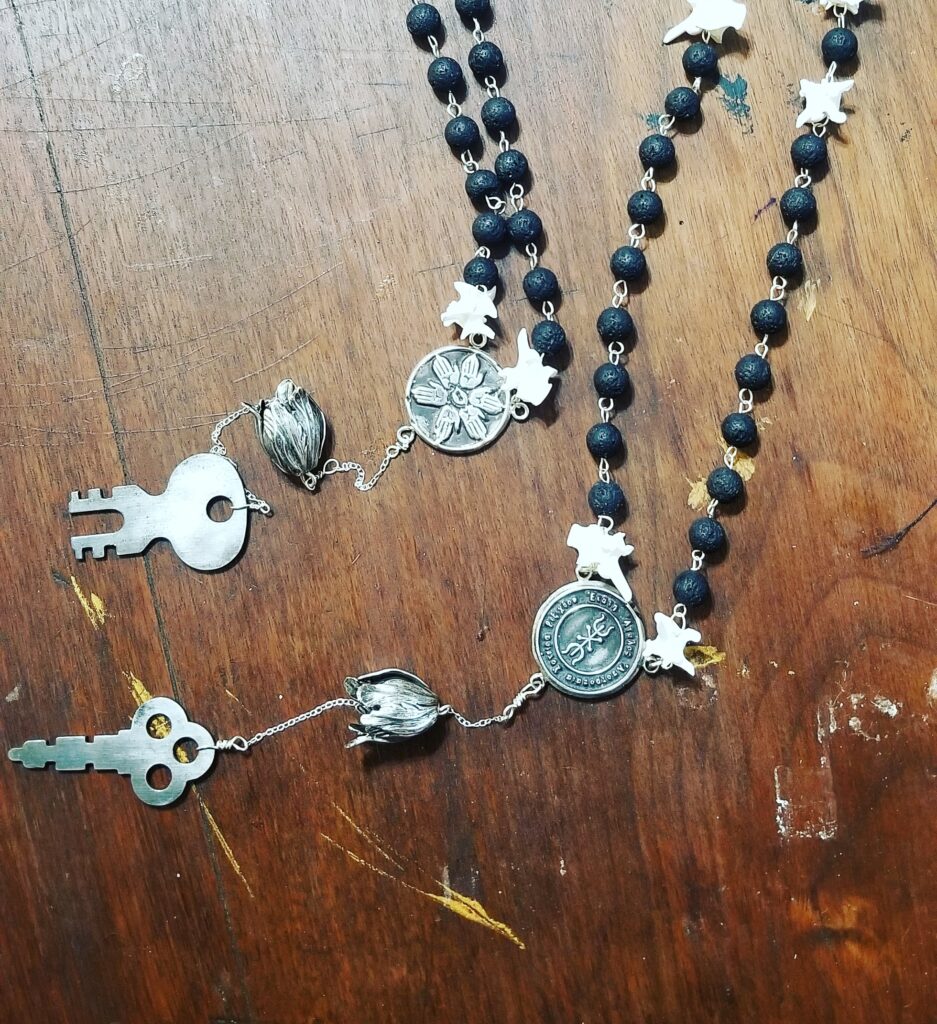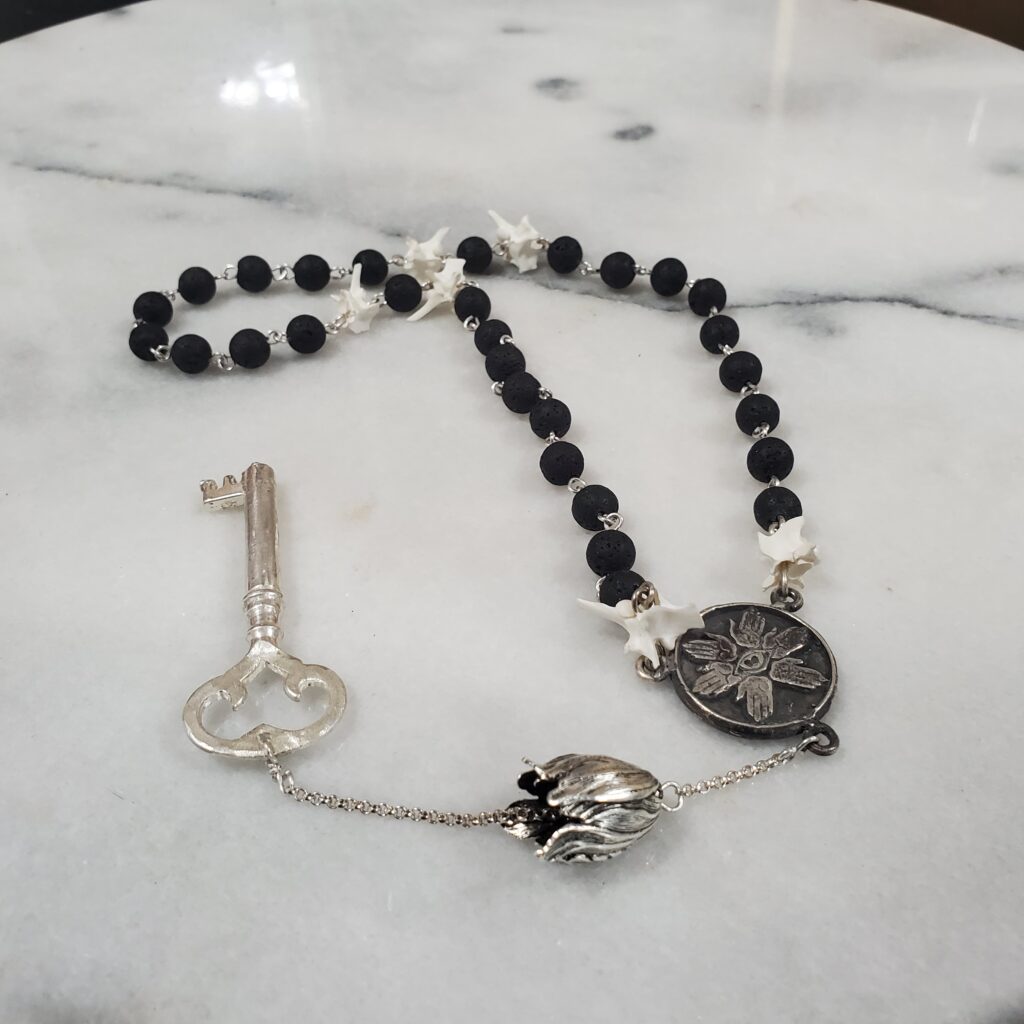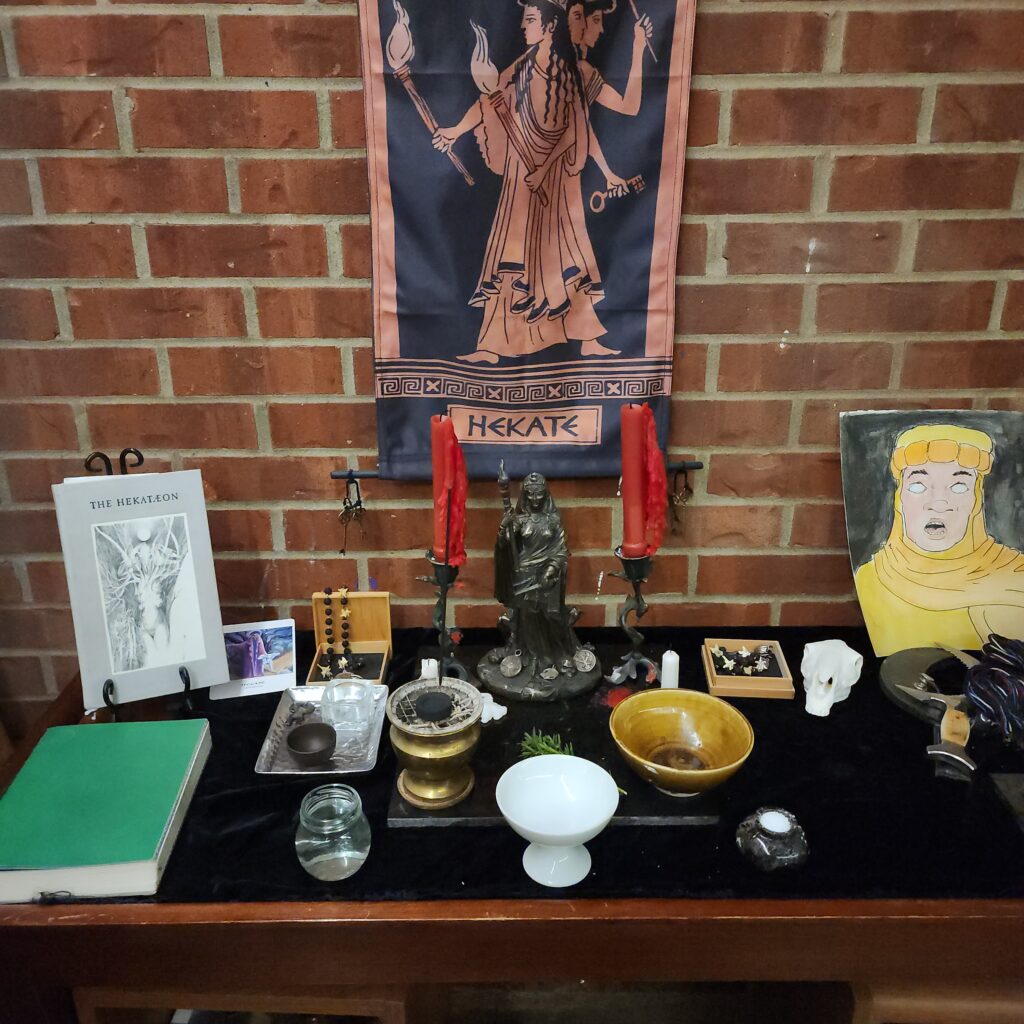Aradia and I began our work with the Hekataeon early in 2019. My notes, unfortunately, do not say exactly when. We made quick work of The Call, but then botched the timing for making our iynxes and had to wait for the next waxing moon. I know, in retrospect, that I was already falling apart at that point, and so it is little surprise that my memory of those months is … vague.
What I remember most clearly from those first days is a sense of dis-ease at the notion of pledging myself to a single god. I rejected monotheism thirty years ago. For all that I love Dionysos above all other gods, henotheism has never been on the table. I expected to be rejected outright, and was surprised when Aradia and I were both given immediate signs to perform the devotion ritual and construct our iynxes.
I remember that I was absolutely confident in my ability to construct the strapholos with nothing more than a poorly exposed photograph and a childhood memory for guidance. I remember being extremely frustrated that the result, however pretty, neither spun nor buzzed the way I expected. I remember that the tiny jelly jar I chose to incubate my iynx in was much, much harder to break than I anticipated. I remember struggling to name the spirit, and to remember the name I had given it (I was even worse at journaling then than I am, now.) I remember feeling, from very early on, that I had failed at that portion of the work. I put the iynx in a drawer and never used it.
In the years since then, many of our friends have acquired their own copies of the Hekataeon. Some began the work and faltered. Others made it to the end of The Call and stopped there. One or two made it as far as we had, and faltered at the same place: the beginning of The Book of the Red Blade, searching for a horse skull or reasonable substitute.
At the beginning of this June, when the Moon was right and when we had managed to carve out space in our schedules, we began (re)working the book as a group – each of us alone in our own temples, but together in spirit. Aradia, Alvianna, and I put together the materials lists and links to the recommended readings that grew into my first post in the To Work the Hekataeon series.
As before, Aradia and I took turns leading the ritual: starting the fires, leading the chants, reading the guided meditations and the recommended readings aloud. Because she still works a day job, I took point on most of the logistical preparations: designing and building the altar, making changes one night to the next to accommodate what had and hadn’t worked quite right, and what needed to change to follow the evolving ritual.
This time, though, I found the work to be a struggle … but not in the ways that I might have anticipated, if I had anticipated any trouble at all.
My ritual practices have grown a lot since I first attempted this work. I have a daily devotional practice which includes Hekate, who has her own altar – the largest of any one god in our house. We didn’t need to make a pre-ritual shopping trip: our basic stores covered everything we needed and more. I am a full time artist and witch, now: setting time aside for the ritual was no challenge whatsoever. My spirit-sight, and my ability to hear spirits and gods, has improved exponentially. I could sense Hekate there every night. I could feel the spirits of my stones awaken, grow, and change as we re-consecrated them on the seventh night, and when we put them to use on the eighth (and ninth, but that’s coming in a bit).
I understand, now, as I didn’t then, how to ancient (and modern but with different trauma than me) polytheists saw no dissonance or contradiction in addressing each god as the greatest, ultimate, and supreme creator and savior. I understand now, on a level that I didn’t then, how initiation into multiple mysteries is no infidelity. The comparison is irreverent, but it works the same as “every cat is best cat”. Or, to be irreverent in a different way, the way you engage in certain activities with one lover does not preclude in engaging in other activities with another lover.
On the fourth night, though, my religious trauma kicked in hard. I don’t know what it was about that rite, in particular, that brought it on. For that matter, I don’t know why it didn’t come up sooner. Something about the text for that night took me back to the place I was in my early teens: angry that powers out there existed, demanding our love and devotion, but offering so little protection in return. The conscious dissonance wasn’t there the next nights, but I also didn’t sleep right again until after the New Moon had come and the rites had been completed.
I struggled with the passages about finding yourself worthy in ways that I had not struggled before. What even is “worth” in a mortal sense, let alone a divine one? And, what do you mean “what do I want out of this work”? I want to know what comes from it!
I struggled with the way that, even as I sat down to do this certain work with this one god, it seemed that other gods who have had little to say to me, lately, seemed to show up in ways that they have not in weeks or months or years. I have no impulse toward hennotheism or monotheism or even monism, despite its popularity in circles I frequent, but it seemed strage that this was the time the gods chose to speak. (I will have more to say on this in a future post.)
On Night Eight (ARBITUM), I asked for permission to resume the work of the Hekataeon. I was told no. This both came as a complete surprise to me – Kraken and I had been discussing the possibility just that afternoon – and hurt my feelings more than I would have guessed had I been asked. I don’t remember exactly how I phrased the question, or the questions that followed, but the conclusion was that I was to do a ritual of penance and absolution, for which I turned to one of the sigils in the Book of White Flame: Thea Deinos. I considered doing further divination, but decided against until I had completed that penance.
At dusk on the ninth night, what would have been INVOCATIO, I began by performing the ritual same opening ritual I had done for the last eight nights: i washed my hands with lustral waters and scrubbed them with cinnamon. I burned myrrh and asperged the space. I drew the crossroads sigil and lit three candles. Then I drew the Thea Deinos sigil on my brow, my throat, and my heart. I took the pose of terror and spoke aloud to the goddess. I apologized for abandoning the work. I apologized for whatever I had done to offend her. I spoke of my frustration with the very notion of worth. I spoke of my desire to learn what lay down the path, to experience Mystery for its own sake.
When I was done, I washed my hands again. I scrubbed them with cinnamon. I went back to the rite of the ARBITUM. This time, when I asked permission to resume the work, I was given the black stone of yes. This time, I had follow-up questions prepared. Yes, I could remake my iynx. No I could not follow along with my companions who were proceeding for the first time. Emphatically no (two white stones) I should not hold back for any stragglers. Yes, I could wait for them before beginning the Book of the Red Blade, but also, yes, it would be better for me and the work if I were to go ahead on my own.
And so, when the time came, I held a funeral for my first iynx. I apologized for my failures in constructing the strapholos, and for failing to continue the work, or honor the spirit properly. I apologized to Hekate for the same, and released the spirit into her care. Maybe the funeral wasn’t necessary. I had doubts both before and during. But I had received permission and committed to the course, and for all my doubts, all that I felt as I watched over the funeral pyre was relief.
When the funeral was complete, I walked away to give the ashes time to cool. Then I came back and set up a workbench altar on which to construct my new iynx. Based on a … feeling that had been with me from when I first decided to hold a funeral for my first iynx, I included a pinch of its ashes in the making of the new, after the ashes of the sigils and before the snakeskin and feather.
Performing the funeral for my first iynx, I dubbed the spirit “child of Hekate”. In assembling the new one, it dawned on me – from the component spit – it could as reasonably be considered my child, as well. That is certainly not the relationship that I have felt with any of my other familiar spirits, but I am going to try to hold onto that thought and act accordingly as I continue the work of growing this new soul. No, I don’t know what this might mean or imply. Maybe someday I will. Maybe I wont. And maybe it’s just a delusion.
With so little ritual framework for the burial, exhumation, and re-burial of the iynx, I struggled a little to really invest myself in each stage. Burrying it, initially, felt significant. Drowning it did not. Nor, despite my best efforts to focus my attention, did hanging it. In fact, my first sense that I had performed the ritual correctly, was during my morning ritual on the final day, when I planned to complete the rite at midnight: sitting at my altar, I could feel the potential of the spirit hovering at the edge of my circle. Even so, I felt nothing from the bottle.
It was only during the final ritual, after I had named the spirit and assigned it a form, when I began to spin the strapholos that I finally felt the spirit manifest and ensoul itself in the tool. The Hekataeon tells you to wake yourself in the middle of the night and record your dreams of your iynx. I barely slept, and had no dreams to record. But that’s typical for me, and the lack of prophetic dreams is neither signal nor noise. I felt the iynx quicken in my hands. I know it lives and will serve me.
And now, with my new iynx born and ensouled within my new strapholos, I am ready to skip forward and resume the work that I abandoned in 2019: The Book of the Red Blade. My devotion to Hekate and the Hekataeon is renewed. My familiars – who now number 14, with the completion of the iynx – tell me that I am on the right path. I look forward to continuing to send you these notes from the spiritual wilderness.
If you want to get my posts a week before everyone else, to see the magical experiments that I don’t share with the public, to get first dibs on my elected talismans and fine art jewelry, or just want to support my work, you can do so through patreon. If you’d like to make a one-time donation, or don’t want to deal with all the non-occult content I post on patreon, I also have a ko-fi.



